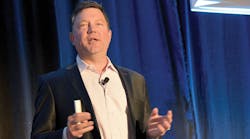3D printing in manufacturing will change how things are made more this century than the industrial revolution has in the last 300 years, said Rick Smith, author of the ‘Great Disruption,’ in a presentation on disruptive technologies at the Truck Trailer Manufacturers Association convention.
If that sounds hard to believe, ask General Electric.
Smith opened his exhortation with the case of M. Arie Kurniawan, who, with no industrial manufacturing experience, won GE’s 3D printing challenge with a radical jet engine bracket design in 2013.
The young Indonesian engineer’s bracket, enabled by industrialized 3D printing technology, passed every test of strength, durability and reliability – yet weighed 85 percent less than the part replaced.
Around the same time, GE’s engineers learned to 3D print a one-piece fuel nozzle that’s 25 percent lighter, four times more durable and increases fuel efficiency by 15 percent compared to the old version, which consisted of 21 parts made around the world and assembled in one location.
“No one expected this would impact the immediate financials of GE, but the implications were disarmingly clear,” Smith said. “If these two parts could be redesigned, what were the opportunities for the company’s other billions of parts?
“(And if) 21 parts could now be made as one, what did this mean for GE’s thousands of parts suppliers relationships?
“I believe this level of disruption is coming to every industry – to your industry.”
Fueled by that belief, the author and entrepreneur co-founded Fast Radius, a 3D printing company backed by UPS that aims to bring “unprecedented speed, scale and quality to additive manufacturing.”
“Manufacturing is so ripe for disruption because, despite 100 years of … improvements, modern manufacturing is still incredibly inefficient,” Smith said. “The entire system of manufacturing has been built on one simple equation, and that is the more things you make, the lower the cost of each.
“3D printing is a way of making things differently from the ground up, layer by layer, until you have a fully formed physical object. Eventually, you’ll be able to print anything that you can imagine.
“(And) with 3D printing, costs are not tied to the number of units produced.”
The technology as a major disruptor isn’t a prediction, it’s a pattern.
The revolutionary Gutenberg press led to the mass production of information, but the internet allows for the mass customization of information, causing an ongoing disruption to the publishing industry.
Commuter trains, and the first cross-country railroads, allowed for the mass production of transportation. Then Henry Ford designed his first automobile, leading to the mass customization of the industry.
3D printing will do the same for manufacturing – at an even faster pace.
“With most technologies, at their introduction, costs are high and quality is low compared to current technologies,” Smith said. “But costs have been dropping and quality’s been rising pretty dramatically.”
So is the speed of 3D printing, which dates to the 1980s. Carbon’s M1 printer, which debuted two years ago, pulls parts out of liquid resin at speeds up to 100 times faster than stereolithography.
The business applications, including customization and complexity, are endless.
For an example of the potential customization of the technology, Google the new Adidas Futurecraft 4D featuring a 3D-printed midsole that is tailored to an individual’s foot and athletic applications.
“Our stated goal is that we would like to create a 1 billion-square-foot warehouse that is completely empty, where all the parts are stored digitally and produced on demand wherever in the world they’re needed,” Smith said.
As for complexity, 3D printing isn’t limited by traditional manufacturing constraints.
“(When) you can make any geometry, then you can start to use any amount of information to create geometries designers never could have imagined on their own,” Smith said.
Smith anticipates three Fast Radius product announcements this summer and fall that will leave industry competitors “dumbfounded.”
He doesn’t want truck and trailer manufacturers left feeling the same.
“The goal of a leader is not to be surprised by change, it’s to anticipate change and write yourself successfully into that story,” he said. “As a leader you need to prepare yourself.
“You need to anticipate that your biggest competitor is going to do something disruptive.”










